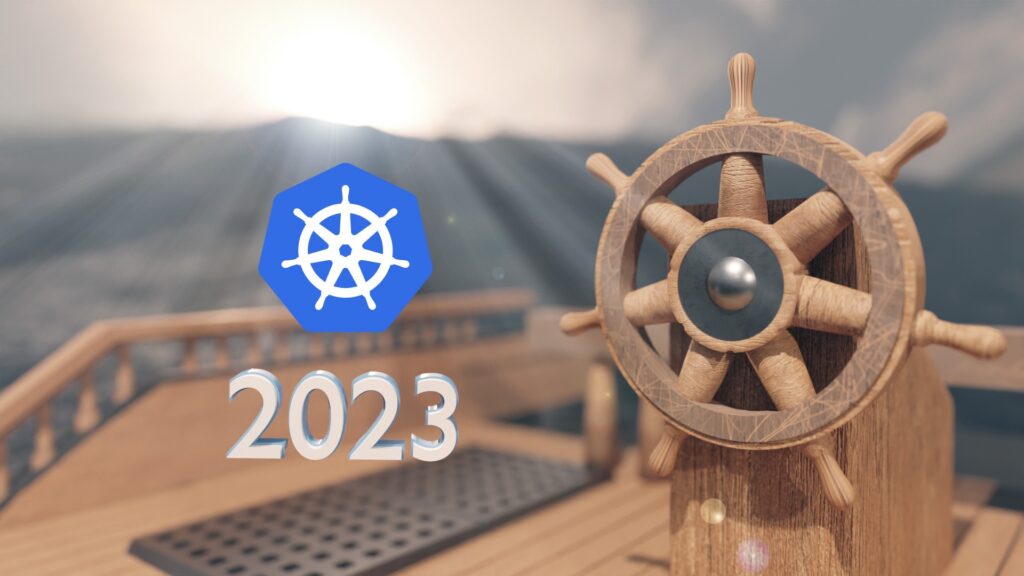What can we expect for Kubernetes in 2023?

As Kubernetes approaches the eighth anniversary of its first version launch, we look into the areas of significant change. So what does the Kubernetes ecosystem look like and What can we expect for Kubernetes in 2023? In short, is huge and continues to grow. As more businesses, teams, and people use it as a platform for innovation, more new applications will be created and old ones will be scaled more quickly than ever before, fuelling its continual development.
The State of Kubernetes 2022 study from VMware Tanzu and the most recent Annual Cloud Native Computing Foundation (CNCF) Survey both indicate that Kubernetes is widely adopted and continues to grow in popularity as a platform for container orchestration. These studies suggest that Kubernetes has become a de facto standard in the industry and its adoption will likely continue to increase in the coming years.
Anticipated Shift towards Kubernetes on multi cloud
As we move forward into 2023, it’s becoming increasingly common for businesses to utilize multiple cloud providers for their Kubernetes deployments. This trend, known as multi-cloud/hybrid deployments, often involves the use of container orchestration and federated development and deployment strategies. While there are already tools available for deploying and managing containers across a variety of cloud providers and on-premises platforms, we can expect to see even more advancements in this area. Specifically, there will likely be an increase in technology that makes it easier to create and deploy multi-cloud systems using native cloud services that work seamlessly across different providers.

Multi-cloud adoption allows businesses to take advantage of the strengths of different cloud providers, such as leveraging the best database solutions from one provider and the best serverless offerings from another. This approach can also increase flexibility, reduce vendor lock-in, and provide redundancy and disaster recovery options. Additionally, it can allow for cost optimization by taking advantage of different pricing models and promotions offered by different providers.
Continual Evolution of DevOps and Platform Teams:
To survive in this digital age, businesses need to have a diverse set of skills and knowledge areas within their workforce. Close collaboration between different departments and disciplines is essential for leveraging new technologies like Kubernetes and other cloud platforms. However, these technologies can be difficult to learn and maintain, and teams may struggle to gain in-depth understanding of them. Businesses should focus on automation and acceleration, but also invest in training and development programs to help their teams acquire the necessary skills to effectively use these technologies.
Companies of all sizes should think about where they want to develop their Kubernetes knowledge base. Many businesses choose a platform team to develop and implement this knowledge. Multiple DevOps teams can be supported by a single platform team. This separation allows DevOps teams to continue concentrating on creating and running business applications while the platform team looks after a solid and dependable underpinning platform.
Improved Stateful Application Management:
Containers were originally intended to be a means of operating stateless applications. However, the value of running stateful workloads in containers has been recognised by the community over the last few years, and the newer versions of Kubernetes have added the required functionalities. Now there are better ways to deploy stateful applications, but the outcome is far from ideal and inconsistent.
By including a controller in the cluster, K8s operators can resolve this difficulty. Reconciliation loops are controller loops that monitor differences between the current and intended states and adjust return the current state to the desired state.
Maturity in Policy-as-Code for Kubernetes
The goal has been to give teams more autonomy when delivering applications to Kubernetes for several years. In many businesses today, creating pipelines that can quickly send out apps is standard procedure. Although having autonomy is a great advantage, maintaining some manual control still requires finding the proper balance. The transition to everything as a code has opened a plethora of opportunities. Following accepted engineering principles will make it simple to validate and review policies defined as-code. As a result, the importance of policy frameworks will increase. Within the CNCF, Open Policy Agent (OPA) is the most common policy framework.
Practices like this will advance concurrently with the adoption of Kubernetes and autonomous teams to enable continual growth while preserving or even gaining more control. Adoption enables you to control how Kubernetes is used by a wide range of teams.

Enhanced Observability and Troubleshooting capabilities:
Troubleshooting applications running on a Kubernetes cluster at scale can be challenging due to the complexity of Kubernetes and the relationships between different elements. Providing teams with effective troubleshooting solutions can give an organization a competitive advantage.
The Four elements (Events, Logs, Traces, Metrics) are important in understanding the performance and behaviour of a system. They provide different perspectives and details on system activity, and when combined, give a more complete picture of the issue. Solutions that integrate these four elements can aid in faster troubleshooting and problem resolution and can also help in identifying and preventing future issues. Vendors and open-source frameworks will continue to drive this trend.

Focus on supply chain security:
Software supply chain security has been in laser sights for a while now, as most software rooted from other software. The necessity of ensuring Kubernetes’ strength has increased along with its importance as it becomes more widely adopted, it is important to ensure its security as it is a critical component of the software supply chain. This includes securing the infrastructure on which it runs, as well as securing the containerized applications that are deployed on it. The “4C’s of cloud native security” model is a good place to start thinking about the security of the different layers of a cloud native application: Cloud, Clusters, Containers, and Code. Each layer of the Cloud Native security model builds upon the next outermost layer, and they are equally important when considering security practices and tools.
This can be done through a variety of methods, such as using secure configurations, implementing network segmentation, and using tools for monitoring and incident response. Additionally, it is important to stay up to date with the latest security patches and updates for Kubernetes and the underlying infrastructure.
It is expected that there will be increased emphasis on Kubernetes supply chain security in 2023, with a focus on features such as container image signing and verification, as well as the signing of Helm charts. Additionally, there will likely be more attention paid to hardening and securing the underlying cluster and nodes. These measures will help to ensure the integrity and security of the Kubernetes deployment and protect against potential threats and vulnerabilities.
In Conclusion, Kubernetes ecosystem is at an interesting point in its growth toward maturity. With continued, or even accelerated, adoption of Kubernetes. Businesses and engineering teams are shifting their focus more towards the operations of their Kubernetes workloads instead of the transformational aspects. This could feedback into as early as the design phase by implementing changes to make operations more sustainable in areas such as: security operations, application lifecycle management, observability, and service management. This requires a shift in engineering practices as well as the tools and technologies used as the ecosystem continues to evolve.
